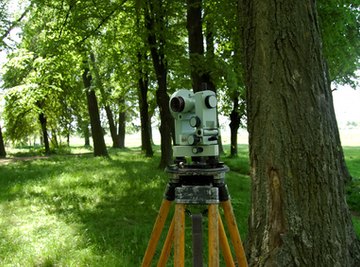
A theodolite is an instrument used in survey testing and in archaeology to measure horizontal and vertical angles. Typically a theodolite has a small telescope that is attached to devices that measure angles and has a variety of moving parts. Because theodolites tend to be quite heavy they are usually fixed on a base that is rotated on a tripod. There are several types of theodolites but the most common can be categorized into three types.
Repeating Theodolite
A repeating theodolite measures angles on a graduated scale. The angle measurement is then averaged by dividing the total of these readings by the number of readings taken. Typically, a repeating theodolite is used in locations where the base is not steady or where space is too limited to use other instruments. Repeating theodolites are considered more accurate than other theodolite types because errors are reduced by comparing values of multiple readings instead of a single reading.
Direction Theodolites
Direction theodolites determine angles through a circle. The circle is set while the theodolite's telescope is directed at several signals. The readings are acquired from every direction. The angle measurements are determined by subtracting the first reading from the second reading. Direction theodolites are commonly used by surveyors in triangulation, which is the process of determining a point by measuring the angles from known points on a permanent baseline.
Vernier Transit Theodolite
A vernier transit theodolite has a telescope that flips over to allow back sighting and angle doubling, which is believed to result in fewer errors in reading. However, vernier transit theodolites are considered to be less precise than other types because they do not have features like scale magnification or measurements in micrometers. Vernier transits are commonly used on construction sites because they are relatively lightweight and easily moved around. Although there are some vernier transit theodolites which measure both horizontal and vertical angles, some only measure horizontally.
References
About the Author
Renee Miller began writing professionally in 2008, contributing to websites and the "Community Press" newspaper. She is co-founder of On Fiction Writing, a website for writers. Miller holds a diploma in social services from Clarke College in Belleville, Ontario.
Photo Credits
theodolite image by Kostyantyn Ivanyshen from Fotolia.com
